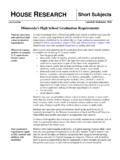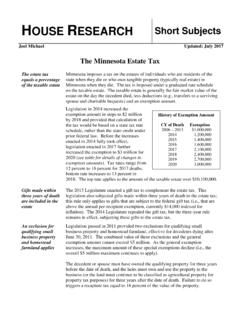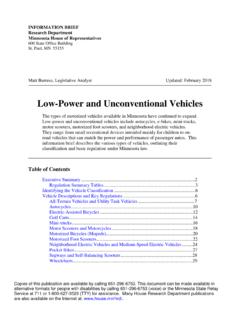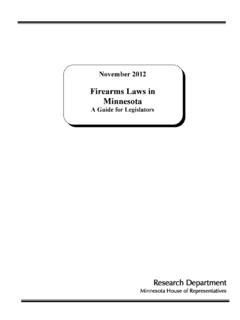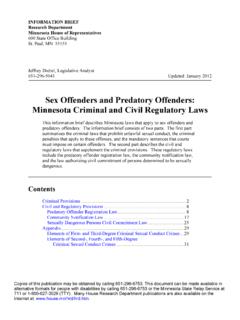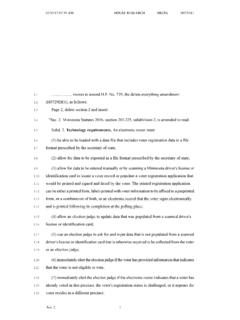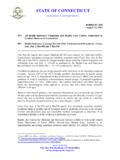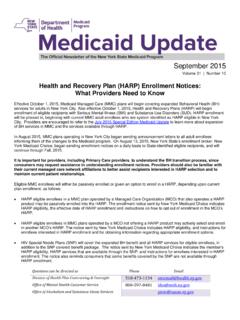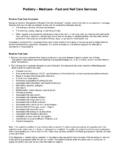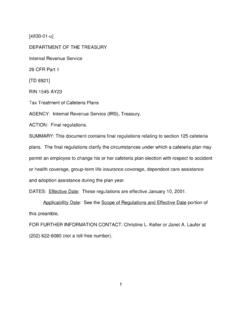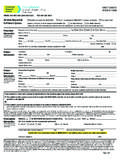Transcription of Medical Assistance Treatment of Assets and Income
1 Copies of this publication may be obtained by calling 651-296-6753. This document can be made available in alternative formats for people with disabilities by calling 651-296-6753 or the Minnesota State Relay Service at 711 or 1-800-627-3529 (TTY). Many House Research Department publications are also available on the Internet at: INFORMATION BRIEF Research Department Minnesota House of Representatives 600 State Office Building St. Paul, MN 55155 Sarah Sunderman, Legislative Analyst 651-296-8079 Updated: August 2018 Medical Assistance Treatment of Assets and Income For Persons Seeking Long-term Care Services This information brief outlines the general Income and asset limits in the Medical Assistance (MA) program, explains the spousal impoverishment provisions for people receiving long-term care services who have spouses that live in the community, and summarizes the prohibitions against an MA applicant or recipient transferring Assets or Income for less than fair market value.
2 Please note: This information brief provides general information on the spousal impoverishment provisions and transfer prohibitions under the Medical Assistance program. The House Research Department provides services to the Minnesota House of Representatives; it does not and cannot represent or provide legal services to private individuals, private entities, or other government organizations. For advice or an opinion as to what law applies in a specific situation, the person involved will need to contact his or her own attorney or advisor. Contents Executive Summary .. 2 MA Program Long-term Care Coverage .. 2 General Income and asset Limits in the MA Program .. 3 MA Program Provisions for Dividing Income and Assets .. 4 Prohibitions on asset and Income Transfers .. 7 Appendix A: Exceptions to the Transfer Prohibitions .. 10 Appendix B: DRA 2005 Changes .. 12 Appendix C: 2016 Spousal Impoverishment Changes.
3 15 House Research Department Updated: August 2018 Medical Assistance Treatment of Assets and Income Page 2 Executive Summary Medical Assistance (MA) provides payment for nursing home and other long-term care services for people whose Assets are at or below the limits prescribed in state law and whose Income has been used to pay health service bills. The MA program limits the amount of Income and the value of Assets a recipient may have. If an MA recipient lives in the community and is age 65 or older, the Income limit is $1,012 per month, or $1,372 for a couple. Individuals with incomes higher than this can spend down their Income to qualify for MA. MA recipients who live in a nursing home must contribute most of their Income to the cost of nursing home care. The asset limit is $3,000 for an individual and $6,000 for a couple. Several Assets are excluded from the MA asset limit. The MA program specifies how the Income and Assets of a married couple are treated when one spouse receives long-term care services and applies for MA.
4 At the time of application for MA, an asset assessment is conducted. In 2018, the spouse receiving long-term care can transfer Assets to the spouse who is still living in the community to bring that spouse s Assets to a maximum of $123,600. The long-term care spouse must use nearly all of his or her Income to pay for the cost of long-term care services, while the community spouse can keep all of his or her Income and is not required to pay for the care of the long-term care spouse if that spouse is eligible for MA. The MA program places some prohibitions on the transfer of Assets and Income . In general, a person seeking or receiving long-term care cannot transfer Assets or Income for less than fair market value, though there are several exceptions. If a person does so, he or she may lose eligibility of MA coverage of long-term care services. MA Program Long-term Care Coverage MA provides coverage for nursing home and other long-term care services to qualified persons.
5 Medical Assistance (MA), Minnesota s Medicaid program, is the federal-state program that reimburses health care providers for services to persons who meet program eligibility requirements. The MA program will pay for long-term care services for individuals whose Assets are at or below the limits prescribed in state law and whose Income , minus certain deductions, has been contributed toward the cost of long-term care services. Minnesota s MA program also has federal approval to provide home and community-based waivered services to certain MA House Research Department Updated: August 2018 Medical Assistance Treatment of Assets and Income Page 3 recipients who would otherwise need nursing facility or other institutional level of Persons can apply for MA by contacting their local county or tribal human services agency. General Income and asset Limits in the MA Program The MA program sets limits on the amount of Income and the value of Assets a recipient may have.
6 Income is defined as net countable Income after certain allowable deductions have been subtracted. Assets include all real and personal property owned by the recipient. When a married couple is living together and neither spouse is receiving long-term care services, all Assets and Income of each spouse are considered available to the other in determining eligibility for MA. In general, an MA recipient living in the community who is age 65 or older may have Income of no more than $1,012 per month. (This limit is $1,372 for a couple.)2 However, individuals with incomes higher than these limits can still qualify for MA by spending down their Income . Spending down means that the individual pays for Medical expenses out-of-pocket that equal or exceed the amount by which the individual s Income exceeds the MA spenddown In contrast to an MA recipient living in the community, an MA recipient living in a nursing home must contribute most of his or her Income towards the costs of nursing home care (see page 5).
7 The MA asset limit is $3,000 for an individual and $6,000 for a couple. The following Assets are excluded from consideration when eligibility for MA is determined:4 The homestead (real property or personal property used as a home), subject to an equitylimit of $572,000 effective January 1, 2018 (see Appendix B for more details) A motor vehicle, regardless of value, if it is used for transportation of the recipient or amember of the recipient s household Household goods and certain personal effects1 For more information on home and community-based waivered services, see the House Research Department publication, Medicaid Home- and Community-Based Waivered Services, October 2017. 2 These Income limits are effective July 1, 2018, and are set at 100 percent of the federal poverty guidelines. They are adjusted each July 1 to reflect changes in the federal poverty guidelines. 3 See Minnesota Statutes, section , subdivision 5c.
8 As of July 1, 2018, the spenddown limit for persons who are elderly, blind, or disabled is 80 percent of the federal poverty guidelines ($809 per month for an individual and $1,097 per month for a couple). 4 See Minnesota Statutes, section , for a more complete explanation of asset limits in the MA program. Personal property means all property other than real estate. House Research Department Updated: August 2018 Medical Assistance Treatment of Assets and Income Page 4 Prepaid burial spaces and burial space items Burial funds (up to $1,500 each for the recipient and the recipient s spouse), prepaidfuneral trusts ($2,000), and life insurance or annuity-funded burial arrangements undercontract Capital and operating Assets of a business necessary to earn an incomeIn addition, if an applicant for MA payment of long-term care services has exhausted benefits under a long-term care insurance policy issued on or after July 1, 2006, and that policy qualifies under the state s long-term care partnership program, an amount of Assets equal to the dollar amount of benefits paid out under the qualifying policy is disregarded for purposes of determining eligibility for MA payment of long-term care services.
9 These Assets are also protected against estate recovery5 and are not subject to asset transfer MA Program Provisions for Dividing Income and Assets Definition of Terms Long-term care services: For purposes of spousal impoverishment provisions, long-term care services means care provided in a nursing facility, hospital, an intermediate care facility for persons with developmental disabilities (ICF/MR), or home care services that would be covered through the Elderly Waiver or the Alternative Care program. The other home and community-based waiver services, Community Alternative Care (CAC), Community Alternatives for Disabled Individuals (CADI), Developmental Disabilities (DD), and Traumatic Brain Injury (TBI), are also long-term care services. Long-term care spouse: The spouse who is receiving long-term care services for at least 30 consecutive days and is married to a community spouse. Community spouse: The spouse living in the community who is not receiving long-term care services and is married to a long-term care spouse.
10 The MA program specifies how the Income and Assets of a married couple are treated when one spouse receives long-term care services and applies for MA. When one spouse seeks MA coverage for long-term care services for a continuous period expected to last at least 30 consecutive days, the MA program uses spousal impoverishment 5 Federal and state law require the Department of Human Services and local county or tribal agencies to recover costs that MA paid for specified health care services through estate recovery processes. For more information, see the House Research Department publication, Medical Assistance Estate Recovery and Liens, November 2017. 6 See Minnesota Statutes, section , for a more complete description of the long-term care partnership program. House Research Department Updated: August 2018 Medical Assistance Treatment of Assets and Income Page 5 provisions to divide the Income and Assets of the married couple in order to determine how much of the couple s total Assets and Income will be designated for each These provisions are intended to allow the community spouse to retain an adequate level of Income and Assets , while requiring the long-term care spouse to contribute most of his or her Assets towards the cost of his or her care (see Appendix C for more details).

